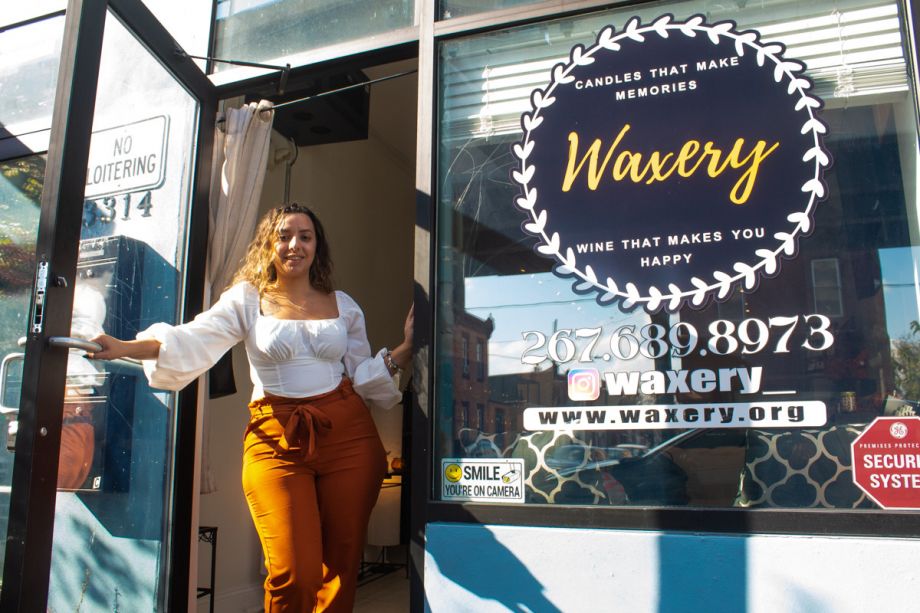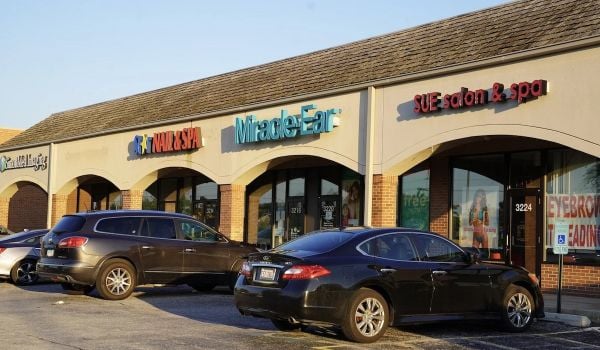Born and raised in Philadelphia’s Kensington neighborhood, Crystal Ortiz believes it deserves to be a place where residents can go out and have a nice evening with friends and family. Known as the center of the region’s opioid epidemic, the Kensington neighborhood is currently reeling from a weekend shooting that put nine people into the hospital. Ortiz’s vision may seem far from the reality today, but she’s already become a crucial part of changing it.
Ortiz opened her business, the Waxery, in 2021. It offers classes to make candles by hand while snacking, mingling and maybe having a glass of wine — in the beloved local custom of “B.Y.O.,” bring your own bottle.
“It’s just something I felt like I wanted to open up so everybody could be united and do something in the area instead of going downtown or far out in New Jersey,” Ortiz says. “I wanted to open something up within my community.”
To get to her original location, you first had to get buzzed into the recently rehabbed J-Centrel building, inside a cavernous former textile mill along the Kensington Avenue corridor. Once inside, you’d then walk down a long corridor until you found her studio.
Earlier this year, Ortiz started walking up and down Kensington Avenue looking for a proper storefront she could rent out for her growing business. When she found it right down the street, she was delighted that she didn’t have to deal with a real estate brokerage, an absentee landlord or some Wall Street-backed real estate investment trust looking to extract profit from the property.
Ortiz’s new landlord is the neighborhood where she grew up. In October, she signed a lease with the Kensington Corridor Trust for the storefront at 3314 Kensington Avenue. She’s the trust’s first commercial tenant. It’s a new type of commercial real estate entity that, as previously covered in Next City, is attempting to put control over the corridor’s future economic development into the surrounding community’s hands.
“I wanted to stay in the area because I grew up here,” Ortiz says. “I potentially want to open up more locations around the city or farther out. But I’ll always have at least one location here.”
The Kensington Corridor Trust is one of several community-owned or community-led commercial real estate entities at various stages of formation and implementation across the country, and they’re starting to get more notice. Next City has previously covered several, including Oakland’s East Bay Permanent Real Estate Cooperative; the E.G. Woode commercial real estate collective in Chicago; the NorthEast Investment Cooperative in Minneapolis; The Guild in Atlanta; the East Portland Community Investment Trust; and Seattle’s El Barrio Community Trust.
A handful of such community-owned commercial real estate examples just made it into a new report from the Local Initiatives Support Corporation (LISC), “Commercial Community Ownership as a Strategy for Just Development.”
“We were trying to look at a range of different local contexts and case studies,” says Julia Duranti-Martínez, author of the report. “Some are community land trusts, some are not. Some are about fighting speculation and commercial property warehousing, some are about the challenges of distressed commercial corridors and cultivating local economic bases as opposed to bringing in larger employers.”
All of the LISC report examples predate the 2020 racial uprisings and the pandemic, but both of those events heightened urgency around commercial corridor development, according to Duranti-Martínez, who works with LISC’s national office. Growing interest in models for community-owned commercial real estate from LISC’s 38 regional offices helped spur the production of this new report.
As documented in the new report, LISC’s Twin Cities office has increasingly found itself in discussions and transactions to support the new Partnership in Property Community Land Trust, which acquired three commercial properties in 2021. It’s become part of healing the institutional as well as physical damage related to the police killing of George Floyd at a prominent commercial intersection in Minneapolis.
“For Partnership in Property CLT, the partners behind it had been exploring a commercial CLT model before George Floyd and then during the aftermath it became part of restoring the commercial corridors damaged during the uprisings,” Duranti-Martínez says.
Ownership over commercial corridors is an important factor for the development of neighborhoods, but it hasn’t been the focus of as much policy as affordable housing or homeownership. Due to historic – and ongoing – barriers in access to credit or opportunities in commercial real estate, it’s common for commercial corridors in Black or Latino neighborhoods to remain in the hands of property owners who no longer live in those neighborhoods, if they ever did.
Only 3% of Black households own nonresidential commercial real estate, compared to 8% of white households, according to a report from the Brookings Institution released earlier this year. For households that do own commercial real estate, the average white household owns $34,000 in it, compared to just $3,600 for the average Black household.
“When you’re of the community and you own the property, you can determine the means of production that occupy those properties and you can really shape the culture, and too often people who own the property have no connection to the communities they’re in,” Brookings Senior Fellow and Next City board member Andre Perry told Next City earlier this year. “That’s very true of commercial properties.”
There are some early lessons from community-owned commercial real estate. Some of the stronger examples so far, as identified in the new LISC report, are entities that went out and acquired properties first, then afterward have gone about establishing community leadership or community decision-making models for their portfolios.
In Alaska’s largest city, the Anchorage Community Land Trust acquired nine properties over the course of 2005-2011, using all private funding. The properties now house space for seven nonprofit organizations; a building that houses the CLT’s office and a training center and art studios for Alaska Native and American Indian artists; a restaurant; a credit union; and also the 28,000 square-foot Grow North Farm and farmer’s market.
In Portland, the East Portland Community Investment Trust recently celebrated its fifth anniversary. While it has only one property, a small shopping plaza on the far east edge of the city, the property has 29,000 square feet of retail and office space, much of which is below ground. Five years ago, when the trust acquired it, it was around two-thirds leased up and in distress. Today it’s almost 100% leased up, with more than 30 tenants, including an immigrant-owned local taxicab service, several other immigrant- and refugee-serving organizations, a large hair salon, and a mental health services provider for transgender youth.
In Los Angeles, the Community Owned Real Estate or CORE partnership formed in 2019, bringing together two local nonprofit community development corporations and two local community development lenders. The CORE partnership now has five buildings in its portfolio with more than 20 commercial tenants, according to the new LISC report.
Meanwhile, beyond the LISC report’s case studies, Seattle’s El Barrio Community Trust and the Kensington Corridor Trust have also taken the approach of acquiring properties before fully building out their community leadership structures. El Barrio Community Trust, while still technically in formation, already has three buildings and a parking lot under its control in Seattle’s South Park neighborhood.
The Kensington Corridor Trust now has 15 properties in its portfolio, all along Kensington Avenue, 12 of which are vacant properties. Ortiz’s storefront is among the first three buildings that the trust has acquired turnkey, and the interim community leadership of the trust is now recruiting tenants for its other two storefronts. The trust’s first infill construction site is two doors down from the Waxery, at 3310 Kensington Avenue. To raise funds for property acquisition, the trust has been borrowing low-cost loans from foundations, some of them local.
Working in parallel over the past few years, Kensington Corridor Trust’s staff of primarily community organizers have been supporting local residents and small business owners to build out the trust’s decision-making process. A working group of residents, civic and business leaders spent a few months earlier this year hashing out values statements and a structure for a stewardship committee to be named later this year. It’s one of the more sophisticated decision-making structures envisioned among community-owned commercial real estate efforts, though it’s still really in its early days.
“I think that the trust is trying to keep its own power within the community,” says Cristina Laboy, a social worker who served as part of the working group and has lived in and around the Kensington area most of her life. “I think it’s going to allow opportunities for individuals to live in a good building that’s affordable or be able to rent one of their storefronts or contribute in other ways. It’s awesome to have that control for the community.”
This article is part of The Bottom Line, a series exploring scalable solutions for problems related to affordability, inclusive economic growth and access to capital. Click here to subscribe to our Bottom Line newsletter.

Oscar is Next City's senior economic justice correspondent. He previously served as Next City’s editor from 2018-2019, and was a Next City Equitable Cities Fellow from 2015-2016. Since 2011, Oscar has covered community development finance, community banking, impact investing, economic development, housing and more for media outlets such as Shelterforce, B Magazine, Impact Alpha and Fast Company.
Follow Oscar .(JavaScript must be enabled to view this email address)


















